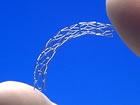| << To Blog Home >> | |
|
|
August 22, 2009 -- 3:10pm PDT Drug-Eluting Stents: Looking Back
Quite so. After all, DES usage (at the time a $5 billion per year business) fell from 90% to 58% in a matter of months. Financial analysts were quite fixated on documenting those numbers. As were the discussions during subsequent cardiology meetings, such as the October 2006 TCT (see "Stent Wars Across the Atlantic: USA vs. Europe") reaching a peak in December at a special two-day Stent Safety Panel, convened by the FDA. I remember sitting in the hotel conference room in Gaithersburg, watching PowerPoint after PowerPoint about drug-eluting stent trial results, listening to the Swedish cardiologists present the SCAAR study which significantly ramped up fears about stent thrombosis, anecdotally referring to DES as the "death stent". I watched the executives and medical directors of the stent manufacturers being grilled by the FDA panel and saw panel members' incredulous reactions to the fact that there really wasn't very good data on long-term use of antiplatelet therapy or on "off-label" indications. I listened to the constant clacking of keyboards, as reporters from NBC, Wall Street Journal, New York Times instantly launched the speakers' words into cyberspace. I also testified to the panel on behalf of patients who were confused and scared about the "tiny time bombs" in their hearts. And I remember stopping Daniel Schultz, head of FDA's device division, in the parking lot and thanking him for convening this important meeting. So much for fond remembrances. Two weeks ago Daniel Schultz announced he was resigning his position "by mutual agreement". He'd been criticized for being too close to industry and with the change that's occurred in Washington, the FDA and...well, thank you very much, time to be on my way. (BTW, my observation at the 2006 Stent Safety Panel from the looks on the faces of the various industry execs, was that this had not been a happy pro-industry session!). However, some of the questions raised then have been answered (others not, but that's another column). The Swedish SCAAR Registry team totally reversed itself a year later (as predicted by Marty Leon and Gregg Stone). When longer time periods and more data were analyzed, there was absolutely no difference in mortality between drug-eluting and bare metal stents. (Sorry 'bout that!) Since the 2006 firestorm, two new 2nd generation drug-eluting stents have been introduced to the U.S. market (Abbott's XIENCE and Medtronic's Endeavor) promising greater efficacy and possibly increased safety. And the recent meta-analysis of DES and BMS in over a quarter of a million patients concluded:
In fact, David Kandzari now estimates that DES usage is back up -- now around 75% and will probably level off at 75-80%. But somehow we haven't been reading headlines about these reversals of fortune. I guess "About those tiny time bombs in your heart -- never mind" doesn't quite capture the headline writers' imaginations. Makes one pine for the good ol' days of 2006.... |
|


 This
past month has offered an odd bit of reminiscence about
an object of ongoing interest: the drug-eluting
stent (DES). First a study from Duke was published in
This
past month has offered an odd bit of reminiscence about
an object of ongoing interest: the drug-eluting
stent (DES). First a study from Duke was published in